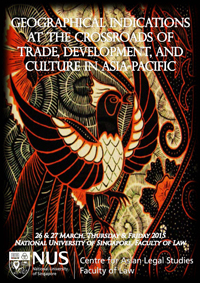Projects
- Projects
- Geographical Indications at the Crossroads of Trade, Development and Culture in Asia-Pacific
Geographical Indications at the Crossroads of Trade, Development and Culture in Asia-Pacific
This research is funded by the National University of Singapore (NUS) Centre for Asian Legal Studies (CALS).25 March 2015
 Some studies have shown that geographical indications of origin (GIs) can provide higher economic returns to farmers and other holders of traditional knowledge through price premiums, foster tourism and/or enhance rural development. Other studies have argued that protection of GIs can assist in preservation indigenous knowledge and culture. Yet for several decades, despite the important role that they can play in trade, development, and the conservation of culture, GIs have not received mainstream attention by intellectual property scholars. This is changing. More significantly in the past several months, discussions about GIs have become a heated topic of debate among national officials and international trade negotiators in Asia Pacific. The growing interest in GIs in this part of the world can be seen, inter alia, in the fact that GIs feature in the Singapore-EU free trade agreement (FTA) and in the ongoing negotiations for a Malaysia-EU FTA, a Vietnam-EU FTA, an India-EU FTA, and the Trans-Pacific Partnership Agreement (TPP). Additionally, several countries in Asia-Pacific have recently seen expansions in their national laws on the protection of GIs, or national policy-makers are currently discussing the possibility of such expansion.
Some studies have shown that geographical indications of origin (GIs) can provide higher economic returns to farmers and other holders of traditional knowledge through price premiums, foster tourism and/or enhance rural development. Other studies have argued that protection of GIs can assist in preservation indigenous knowledge and culture. Yet for several decades, despite the important role that they can play in trade, development, and the conservation of culture, GIs have not received mainstream attention by intellectual property scholars. This is changing. More significantly in the past several months, discussions about GIs have become a heated topic of debate among national officials and international trade negotiators in Asia Pacific. The growing interest in GIs in this part of the world can be seen, inter alia, in the fact that GIs feature in the Singapore-EU free trade agreement (FTA) and in the ongoing negotiations for a Malaysia-EU FTA, a Vietnam-EU FTA, an India-EU FTA, and the Trans-Pacific Partnership Agreement (TPP). Additionally, several countries in Asia-Pacific have recently seen expansions in their national laws on the protection of GIs, or national policy-makers are currently discussing the possibility of such expansion.
In this climate, policy-makers must have the benefit of a comprehensive analysis of the potential impact of GIs on trade (national, regional, international), development and culture so that they can formulate solutions to address the opportunities and challenges coming with the recognition and exploitation of GIs. However, the available literature on this topic, especially from the point of view of countries in Asia Pacific, is scattered. It is this void that this workshop aims to fill. To this end, this workshop convenes academics and other experts to discuss and critically assess the current developments and the pending proposals on GI protection and their impact on Asian countries. Important lessons will be drown from the experiences-and often diverging positions-on GIs outside of Asia Pacific, particularly in the European Union and North America. In particular, participants in the workshop will address questions such as: the contested nature of GIs and the rationale for their protection; the role of GIs as economic incentives for local communities; the role of GIs in protecting intangible cultural heritage; the long term relationship between GI protection and economic development; and the types of GI protection, namely sui generis rights and trademark protection. Participants will address these questions within the multilateral international framework, bilateral and pluri-lateral trade negotiations, and under several national laws.
The various papers presented at this workshop will later be published in a collective volume, which aims at becoming a trendsetter for a constructive debate on GI protection in Asia and on a global scale beyond this region.

